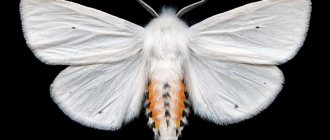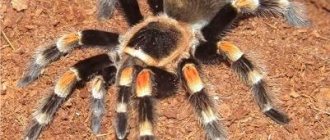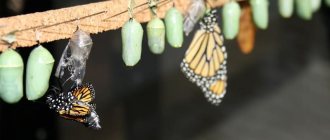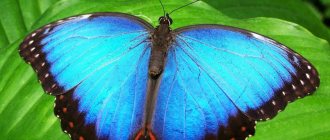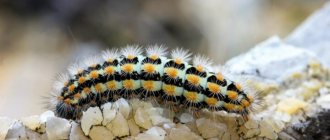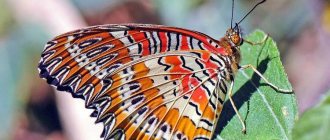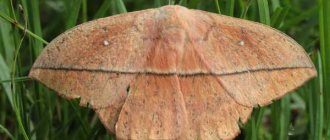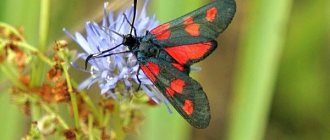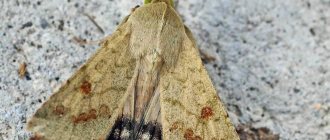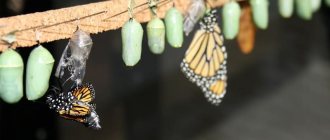Tizania agrippina belongs to the order Lepidoptera, family Noctuidae. This is the largest moth of the moth family.
She is called differently, but each nickname is beautiful in its own way and fully corresponds to the unusual appearance of the winged beauty. Agrippa has several names, including the white witch, scoop agrippa, and sorceress.
Thysania agrippina.
Top 3 largest butterflies on our planet
South American tropical armyworm - tizania agrippina
This insect is called the largest butterfly of the six continents in terms of wingspan.
She has white (or light gray) wings. And on them, as if on a suede Persian carpet, there are patterns in the form of fancy spots and strokes of brown or brown color. By the way, thanks to the uniqueness of its color, the agrippina is the most beautiful butterfly in the world. Although, as they say, the color and taste... Let's call it, just in case, one of the most beautiful. And now - to the dimensions. Data on the wingspan of the largest individual of Tysania differ in various literary sources, however, there is every reason to believe in the exclusivity of this species in terms of their size.
So, in various books, the size of the wings of the largest individual in the history of entomology, Agrippina, varies from 25 to 31 cm. It is worth noting that not all authors report the sources from which they gleaned their sensational information. However, the Tysania's wingspan is usually quoted as being between 270 and 280 mm. We absolutely know about at least two specimens of Agrippina, which can be called the largest butterflies in general that have ever been caught.
The unique long wings of Tysania agrippina are quite narrow, so that their surface area is smaller than that of the other two butterflies. These beauties from New Guinea and South Asia are the Atlas and Hercules butterflies.
Koscinoscere hercules
The wingspan of this largest butterfly (meaning by the area of the wings) can reach up to 28 cm, which is less than that of the tisania. Females have the most impressive dimensions, while males grow smaller in size. However, what distinguishes a male from a female is not only the wingspan, but also some external features. Thus, males are “armed” with very long “spurs”. The Hercules butterfly is found in New Guinea and Australia. Moreover, it is not easy to see it during the day, since it leads a predominantly nocturnal lifestyle.
Peacock eye atlas
This butterfly is only slightly smaller in size than its predecessors - the heroines of our study. The wingspan of the largest individual caught reached 26.2 cm. However, its rating was in third position.
The largest specimen in the entire history of observations of peacocks lived on the island of Java; today butterflies of this species can be observed in the Land of the Rising Sun (China), Indonesia, India, Vietnam, Malaysia, Pakistan, the island state of the Philippines, as well as in New Guinea.
As with the Hercules butterfly, female peacock butterflies grow significantly larger than males. This species is also known by the nickname "prince of darkness." Sounds scary, doesn't it? In fact, the butterfly did not receive its middle name because of its bloodthirstiness. Its diet includes the foliage of trees and shrubs, which the winged creatures “hunt” at night. Hence the nickname. So the most favorable time to observe them is early in the morning, as well as late in the evening.
There is another interesting feature in the biography of the peacock-eye - to serve a person. So, in Taiwan, after the caterpillar hatches, the cocoon remaining from it is used by local residents as a handbag for local currency.
Interesting Facts
Despite the fact that Tizania Agrippina is a rather secretive butterfly, naturalists and simply wildlife lovers managed to find out several interesting facts about it:
- The scoop Agrippina has taken a leading position in the list of giant butterflies due to its wingspan. But in this parameter, she left behind her main competitor - Atlas Peacock-Eyes.
- The average wingspan of the moth, according to various sources, is 25-31 cm. However, according to official statements, the largest specimens of these insects were caught twice. This was first noted in Costa Rica, and measurements of the wingspan of the moth showed a result of 28.6 cm. The second giant butterfly was discovered in Brazil, the same parameter reached 29.8 centimeters.
- The armyworm is able to camouflage itself in a truly filigree manner: the color of its wings so closely resembles the bark of a tree that it is quite easy to pass by the insect very close and not notice it.
- In some states of Brazil, catching cutworms is prohibited; these butterflies are protected by law as an endangered species.
Tizania Agrippina is a unique insect. Having seen it once, a person is unlikely to be able to forget this huge creature, by the standards of ordinary butterflies. The impressive wingspan and unusual coloring make the huge cutworm a record holder, ranking first in size among similar winged individuals.
Tags: butterfly, butterfly Tizania Agrippina
Pyrameis cardui: simplicity and sophistication
Pyrameis cardui is popularly called Burdock. The elegant, moderately simple appearance makes the butterfly unsurpassed and therefore delightful. A representative of the wonderful world of insects lives in all corners of the planet.
Amazing nature never ceases to delight the human eye with its unique representatives of flora and fauna. One can gaze at the magnificence of the most beautiful butterflies in the world for hours. It’s not for nothing that there are various traveling exhibitions of live butterflies around the world, where you can see and personally appreciate the beauty of unique flying insects. Of course, at such exhibitions you rarely see the most beautiful butterflies listed in today’s post, but worthy specimens are definitely found there.
Other giants
The article examined the world's largest butterflies. Also in this row are:
- Ornithoptera (Birdwing) of Queen Alexandra. The wingspan is up to 26 cm. It is the largest daytime butterfly on earth. Found exclusively in the territory of Papua New Guinea.
- The Antimachus swallowtail is the largest butterfly in Africa. Leads a daily lifestyle. The wingspan of males is up to 23-25 cm.
- The pear peacock eye is the largest European butterfly and is nocturnal. The wingspan reaches 15.5 cm.
- Maak's swallowtail is a day moth, the largest in Russia. The wingspan is up to 14 cm. Males have a very beautiful coloring: green threads of various shades shine like lurex on the dark green glossy background of the wings, and black fringe borders the edges. The hind wings are decorated with dark blue spurs.
Tizania agrippina
The South American tropical moth, or tisania agrippina, is a large nocturnal moth from the noctuid moth family. It is the largest butterfly in the world - in 1934, the largest individual with a wingspan of 30.8 cm was caught in Brazil. A similar specimen was caught in 1997 by entomologist Mario Callegari in northern Peru.
Distributed in Mexico, Central and South America. Considered a southern migrant to Texas.
Tizania agrippina
Butterflies are one of the largest groups of insects, including more than 137,000 species, the total estimated number of the order is up to 200 thousand species
Butterflies are the most popular group of insects for private collectors and scientists. This is due to the huge number of species, a wide variety of shapes, their wide distribution, variety of sizes and colors. Collecting butterflies originated a very long time ago. Back in the mid-18th century, English butterfly collectors called themselves Aurelians - from the Latin aureus - “golden” (a hint at the golden color of the pupae of some butterflies). In the mid-19th century, the interior of Victorian houses certainly included a glass cabinet, where, along with shells, fossils and minerals, dried butterflies were also displayed.
As a result of human economic activity - deforestation, plowing of virgin steppes, drainage of swamps - the number of many species of butterflies has decreased significantly, and some of them are on the verge of extinction.
Tizania agrippina
Peacock-eye Hercules
Another large butterfly is the Hercules Peacock-eye, a nocturnal butterfly from the Peacock-eye family. One of the largest butterflies in the world, and the largest in Australia; the wingspan can reach 27 cm. It has the largest wing area among butterflies - up to 263.2 cm2.
We talked about the world's largest butterfly. Below are photographs of butterflies sitting on flowers. They are not as large as the tropical cutworm, but they are very beautiful.
Butterflies are the decoration of all fields and vegetable gardens in the spring and summer seasons. It’s nice to see this insect with the beautiful color of its wings on a branch. However, you and I can rarely meet giant butterflies in the wild; more often they are miniature.
In this article you will learn about who the largest butterfly in the world is, what it looks like and where it lives. An insect of amazing size that pleases the eye with its appearance.
So, the title of the largest belongs to the butterfly tizania agrippina - the wingspan of different individuals is 25-31 cm, most often 27-28 cm. The butterfly is also known under other names - agrippa or scoop agrippina. This is a nocturnal moth, which is why the name moth or moth appeared.
Habitat
Previously, the largest butterfly in the world lived in the southern states of the United States, but due to climate change, it immigrated to Mexico, Central and South America. Most often they can be found in the equatorial rain forests of South America - in the jungle.
Butterflies are graceful and charming creatures that leave no one indifferent. The sizes of these insects range from very tiny to truly gigantic. What is the name of the largest butterfly in the world, where does it live and what does man know about this miracle of nature? Let's find out from this article.
[custom_ads_shortcode1]
How is the size of butterflies measured?
Butterfly size
Why did it happen so? On the one hand, someone wanted to capture the reader’s imagination with butterflies by adding “a little” size, and on the other hand, these data appeared as a result of the way the butterfly wings were spread for the collection. The wingspan of “dried” butterflies from the collections depends on the angle of their expansion - the greater the negative angle between the edge of the forewing and the hind wings, the greater the wingspan of the specimen will be (of course, not to infinity). This little trick is very often used by enterprising collectors to profitably resell their existing butterflies by adding wingspan...
Trigonometric calculation of butterfly wing size
How do you actually determine the size of a butterfly's wings? The most convincing and reliable method is trigonometric calculation using the example of the height of a triangle. So, we multiply the length of the line from the base of the front edge to the top of the front wing by the sine of the angle that this line forms with the axis of the butterfly’s body, and we get the length of one wing. By doubling it, we get the length of the butterfly’s wingspan! According to this method, the largest wingspan recorded for Saturnia Atakus is 26.2 cm.
On the opposite side of the planet - in the tropical forests of the Amazon - Saturnias are also common and they are also striking in their size, although they are still inferior to those of South Asia. For example, Saturnia-Arsenula and Saturnia-Cayo have a wingspan of 19 cm!
The largest butterflies in the world by wing area
The wings of Agrippina are the longest, however, in terms of wing area, the record holders are two other butterflies - Peacock-eye atlas and Koscinoscere hercules. They belong to the peacock eye or saturnia family. The surface area of their wings approaches 300 square centimeters.
The wingspan of female Koscinoscere hercules is about 27-28 centimeters. The males are somewhat smaller, their wings are narrower, their hind wings have long spurs reaching 11-12 cm. Their caterpillars are large - 16-17 cm. The butterflies themselves are unusually beautiful, their color is bright, indeed reminiscent of the feathers of a peacock's tail. The Hercules butterfly is active at night. It lives in Australia and Papua New Guinea and reproduces well in captivity. Caterpillars can be fed with leaves of willow and lilac, bird cherry and walnut, and brook tree.
The Atlas peacock eye has a wingspan of about 26 cm, and males are smaller than females. The caterpillars are soft green in color with bluish processes, powdered with a light coating like powder. Their body length is about 10 cm. The atlas peacock is very beautiful - on its wings you can see many shades of brown, there are red and pink, white and yellow tones. Each of the four wings has fairly large transparent triangles. Because of their activity at night, this species of butterfly is sometimes called the “princes of darkness.” But in Hong Kong they were given the nickname “snake-headed moth” for the unusual shape and color of their front wings. The appearance of this butterfly allows it to repel insectivores. The female can sit for more than one hour waiting for the male. The male, like most members of the peacock eye family, is able to detect the female’s pheromones at a distance exceeding 10 km. This wonderful butterfly has no mouth; it will live for about a couple of weeks, using the reserves that it accumulated as a caterpillar. The habitats of the peacock eye atlas are India and China, Vietnam and Pakistan, Malaysia and Indonesia, the Philippines and New Guinea. The beauty of this butterfly can be appreciated at the Moscow Zoo. In India, this species is found not only in the wild - it is bred on special farms for the purpose of producing fagar silk. It is more wear-resistant than silkworm silk and is also more woolly. The Thais have adapted to using the cocoons of this butterfly as wallets.
Butterflies are amazing insects! An unremarkable caterpillar turns into a creature that has long been considered a symbol of beauty and lightness. Both the smallest representatives of these insects and the largest specimens invariably delight the eye.
Largest butterfly
The moth agrippina is considered to be the largest representative of the Lepidoptera group in terms of wingspan. Various literary sources provide slightly different data on the maximum wingspan of its wings, which range from 25 to 31 cm. At the same time, many authors do not indicate the sources of the information they provide. At the same time, most sources give the maximum wingspan of its wings within the range of 270–280 mm. It is known for certain that there are at least two specimens of the Agrippina cutworm, which can be considered the largest ever caught. The first was caught in Costa Rica and with a front wing length of 148 mm, it has a wingspan of 286 mm. The second, obtained in Brazil, with a wingspan of 298 mm and a front wing length of 134 mm. However, a caveat should be made that these specimens were not distributed in accordance with the standards for entomological collections. The lower edge of their front wings does not form a 90-degree angle with the body, resulting in an “artificial” increase in wingspan. When carrying out a “reconstruction” of the correct mounting of these individuals, their wingspan in both cases does not exceed 27 - 28 cm.
Description
Looking at a butterfly, you involuntarily compare it with large birds. On the light background of the wings there is a clear pattern of alternating light and dark stripes and strokes, creating the illusion of plumage. These so-called feathers have a slightly metallic sheen. The marginal line is sinuous.
The color of butterflies varies from dark to light tones. The lower part of the body is brown with white spots. In males, the abdomen has a blue-violet sheen. The simple pattern on the wings of Tisani agrippina imitates the texture of tree bark and allows the butterfly to easily camouflage itself among vegetation.
One of the largest specimens was caught in Central America in Costa Rica. The length of its front wing reached 148 mm, and the wingspan was 270 mm. The butterfly with a wingspan of 280 mm was brought from Brazil.
Peacock-eye "Atlas"
This butterfly was named after a hero from Ancient Greece who, according to legend, held the entire sky on his shoulders. The wingspan of this giant can reach 26 cm, and these species are found in Southeast Asia.
The beauty flies actively at night, feeding on the foliage of bushes or trees. At dusk, in the morning or as evening falls, Atlas is especially active, for which he is nicknamed the Prince of Darkness.
Peacock-eye Atlas, photo on hand
The Moscow Zoo also breeds the Peacock-Eyes - there you can admire its beauty to your heart's content. In particular, on the insect's wings, which are decorated with shades of yellow, pink and red. At the corners of the butterfly's hind wings there are transparent windows, and the front wings resemble the head of a snake in their shape, which scares away predators who encroach on their lives. The peacock eye, like some other individuals, has no mouth, so during its life (about 2 weeks), it lives only on the reserves accumulated during its life as a caterpillar. Did you know that you can breed butterflies at home? Read more about the home butterfly farm.
Male Atlas peacock-eyes are able to find a female for mating several tens of kilometers away. Moreover, the mating process takes place over several hours. It is worth noting that the process of reproduction is key in the life of females; they die immediately after they create offspring.
What does the pest eat?
The main enemy of the gardener is the moth caterpillar, not the adult. All the adult needs during mating is pollen from flowering plants. She eats it like a bee, without injuring the plant or having a negative effect on it. It’s a different matter for nymphs, who are divided into three types.
- Intrastem. They live inside the stem, actually sucking it from the inside and leading the plant to death.
- Gnawing. Their habitat is open ground. Such caterpillars feed on the root system, gnawing garden crops from below.
- Leaf-chewing. The vast majority of moths belong to this category. Their larvae eat foliage, flowers and plant buds.
There are very, very few plants that the cutworm is ready to reject. The favorites on the menu of this insect pest are cereals, oilseeds, berries and legumes, as well as perennial herbs, grapevines and stone fruit trees.
Female Queen Alexandra's Birdwing
The butterfly with the world's largest wingspan among diurnal species is Ornithoptera alexandrae. A rather interesting story is associated with the discovery of this species in 1906 by zoologist Albert Meek. On the Pacific Islands near Australia, he compiled a collection of insects for the avid butterfly collector banker Rothschild. It was he who in 1907 gave the largest butterfly in the world a name associated with the name of Queen Alexandra, the wife of the English King Edward VII. Since this species flits in the canopies of tall trees, the first specimen obtained, which turned out to be a female, was shot with a gun. Small bright birds, from which they were later made into stuffed animals, were shot down with cartridges loaded with tiny shot or mustard seeds, so as not to damage the birds’ plumage. The same charges were used for large flying insects.
What the world's largest butterfly (among diurnal species) looks like depends on the sex of the individual. Males are smaller, with more graceful and brighter colored wings, the span of which does not exceed 20 cm. Females have a velvety brown coloring with a beige-white pattern. Their wingspan sometimes reaches 27 cm, and their abdomen, 8 cm long, weighs about 12 grams. Ornithoptera alexandrae are endemic, living only in the tropical rainforests of one of the regions of the mountains of New Guinea. After a volcanic eruption in the middle of the last century destroyed most of the lepidopteran population, they are considered a rare species.
The most common of the largest butterfly species is Attacus atlas. The insect is not much inferior in scope and wing area to Koscinocere hercules. You can verify this by looking at a 1922 specimen from the Australian Museum: the wingspan of this individual is 24 cm. Higher figures are often found due to incorrect position of the wings when measuring the insect. Therefore, the atlas peacock eye is not considered the largest butterfly in the world.
Photos of this species are plentiful and easily taken by tourists while traveling in the south-eastern countries of Asia. And this is not surprising, because the habitat of the Atlas peacock eye is very wide in this part of the world, and the list of food plants for the caterpillars is very diverse. Large, thick caterpillars accumulate nutrients on which adult butterflies live, since they themselves do not have a developed mouthparts and do not feed during their short lives.
In India, the species is bred artificially. From the threads of huge (palm-sized) cocoons, high-strength woolly farg silk of natural beige-brown shades is produced on a non-industrial scale. For residents of Taiwan, cocoons often replace wallets.
Sailboat antimah
Papilio antimachus is not considered the largest butterfly in the world, but it is the largest diurnal species in Africa. In this species, the males are larger, the wingspan of which sometimes reaches 25 cm. The average size is 18-23 cm. Such a significant distance between the front wings is created due to their highly elongated apices. Antimah swallowtails are brightly colored creatures with brownish, ocher, orange and red tonal tints of the general background and a dark, almost black pattern.
The first specimen (male) brought to England and given a scientific description dates back to 1775, it was caught in Sierra Leone. Only a hundred years later, a second sample was obtained and found its way to Europe. The first female Papilio antimachus caught was brought to members of Lord Banker Rothschild's expedition by the natives in 1882.
The butterfly's habitat on the African continent is quite wide; it can be found in tropical rainforests. However, the species is one of the few. Males often accumulate in large colonies on plant flowers. Females prefer dense tree crowns and practically do not descend or fly out into open spaces.
This nocturnal insect is considered the most beautiful and longest of all the large butterflies in the world. Even the females of the Madagascar comet, larger and more massive than the males, have a wingspan that does not exceed 18 cm. But their lower corners of the hind wings are excessively elongated. In males, hypertrophied narrow “tails” reach 16 cm, which in total with the rest of the wing length is more than 30 cm. In females, the “tails” are twice as wide and shorter (8 cm).
It's not just its unusual trail that makes the Madagascar comet attractive. Its bright yellow color is decorated with “eyes”, one on each wing, a rich brown color with a black “pupil” dot in the center. The coloring is complemented by wavy brown-red lines, brown-black spots at the tops of the wings and a black border on the lower wings.
Argema mittrei is an endemic species found only in the tropical rainforests of Madagascar. In the country, the species is bred in captivity for sale to collectors. In 1995, a 500 ariary banknote was issued in Madagascar, where, among other endemics of the country, the Madagascar comet is depicted.
Notes
- Life of animals. Arthropods: trilobites, chelicerates, trachea-breathers. Onychophora / Ed. Gilyarova M. S., Pravdina F. N. - 2nd, revised. - M.: Education, 1984. - T. 3. - 463 p.
- Great Soviet Encyclopedia - Volume 4, State Scientific Publishing House, 1950 Pages. 15
- Veybren Landman.
Butterflies. Illustrated encyclopedia. - M.: Labyrinth Press, 2002. - 272 p. — (Illustrated Encyclopedia). — ISBN 5-9287-0274-4.
- Kaabak L. V., Sochivko A. V.
Butterflies of the world. - M.: Avanta+, 2003. ISBN 5-94623-008-5.
- Stanek V. Ya.
Illustrated encyclopedia of insects. - Prague: Artia, 1977. - 560 p.
- Metcalf, G. L. & W. P. Flint. 1951. Destructive and useful insects, 3rd ed. McGraw-Hill, New York.
- Frost, S. W. 1959. Insect life and natural history, 2nd ed. Dover Publications, New York.
- Folson, J. W. 1906. Entomology. P. Blakiston's Son, Philadelphia.
- . .
Reproduction and nutrition of the Erebid family
The reproduction of insects of the Erebid family, of which the moth Agrippina is a representative, is not much different from the same process occurring in other butterflies. Females lay eggs on the underside of leaves or stems of last year's grass, in some cases in the ground. Each butterfly is capable of laying from 500 to 2,000 eggs, their number is largely determined by the quality of the insect's nutrition.
The embryo develops within 5-10 days; the first generation of caterpillars appears approximately in May-June. They pupate in the soil, and after some time the second generation of butterflies is born. Individuals will grow and, in turn, also lay eggs in late summer or early autumn.
Taxonomy
The cutworm Agrippina belongs to the small genus Thysania
(
Dalman
, 1824), which is part of the subfamily
Calpinae
, which belongs to the family
Erebidae
.
Along with it, it includes two more species: Thysania pomponia
(
Jordan
, 1924) and
Thysania zenobia
(
Cramer
, 1777). These two species are significantly inferior to Agrippina in maximum size, having a wingspan of only 10 - 15 cm. All members of the genus are found exclusively in the Neotropical zoogeographic region.
Rating "The largest butterfly." Top 5
1. SCOOP AGRIPPINA IS THE LARGEST BUTTERFLY IN THE WORLD
The first place in the ranking is occupied by the Agrippina moth (it has another name - tizania agrippina. This moth is rightfully considered the largest, since its wingspan reaches 30 cm. The Agrippina moth has a white and gray background of wings, on which there is a dark pattern. The shades of the wings are may vary between individuals.The largest butterfly lives in Central and South America.The typical habitat of the Agrippina cutworm is considered to be the tropical rainforests of Brazil, Peru, Venezuela and other Latin American countries.
Second place in the “Largest Butterfly” rating with a wingspan of 27 cm is occupied by the Queen Alexandra Birdwing. This diurnal butterfly lives in the jungles of Papua New Guinea. The length of the abdomen of this large and beautiful butterfly can reach 8 cm, and its weight is 12 grams. The butterfly larvae measure 12 cm in length and 3 cm in thickness. The wings and abdomen of Queen Alexandra's birdwing are dark brown and white with cream or yellow patterns. Currently, this one of the largest butterflies in the world is prohibited from catching and selling, since the number of this species is small.
3. PEACOCK EYE HERCULES – NIGHT BUTTERFLY OF THE PEACOCK EYE FAMILY
Next... The Hercules peacock-eye is a nocturnal butterfly of the peacock-eye family. It lives in the tropical forests of Australia and the islands of New Guinea. The wingspan of female butterflies can reach 27 cm. The area of its wings - the largest among butterflies - reaches 262 cm2.
The swallowtail antimach is a large day butterfly from the swallowtail family. The wingspan of this butterfly, named after the hero of Greek mythology, reaches 25 cm. Females are larger than males. The Antimach swallowtail lives in the rainforests of Africa. Females most often live in the treetops. This one of the largest butterflies has a red-yellow, orange and even ocher background on its wings, on which dark brown spots form a pattern.
5.ATTACUS ATLAS – BUTTERFLY OF THE PEACOCK EYES FAMILY
Attacus atlas is a butterfly of the Peacock-eye family. It lives in tropical and subtropical forests of China, Thailand, and Indonesia. The wingspan of this large butterfly can reach 24 cm. In India, Attacus atlas caterpillars are cultivated and used to produce silk.
The agrippina moth or, as it is otherwise called, agrippina tysania (Thysania agrippina) is the largest butterfly in the world, the wingspan of which usually reaches 30 cm.
Scoop agrippina
And in 1934, the largest individual of this species with a wingspan of 30.8 cm was caught in Brazil. The owners of the record size among lepidopterans are nocturnal and feed on the leaves of shrubs of the genus Cassia.
Tisani agrippina butterflies can be found in Mexico, Central and South America. They are believed to migrate from southern regions into Texas.
Scoop agrippina
Pattern on the wings of a butterfly of the Tisani agrippina species
However, there is another species of butterfly in the world with no less impressive sizes. A butterfly that lives in the tropical forests of Madagascar, called Argema mittrei, does not have such a large wingspan as the Agrippina cutworm (14-16 cm), but is also considered one of the largest butterflies on the planet. This is so because its wings are larger in area than the wings of Agrippina, and also because individuals of this species have “tails” on the hind wings, which can reach 13 cm.
Argema mitrei. The female Argema mithraea accumulates all the necessary food reserves in the caterpillar stage, since, as an adult, this butterfly does not feed at all.
Argema mitrei (bottom view).
Argema mittrei (top view)
Scoop agrippa
Thysania agrippina is a nocturnal moth and the largest in the world based on its wingspan. According to various sources, it reaches 25-31 cm. A collection specimen from Costa Rica is known, which had a span of 28 cm. The span of another Brazilian specimen, caught in 1934, was 30.8 cm. But this is not known case, how accurately the measurements were taken.
The coloring of the insect's wings is quite inconspicuous: on a light gray, almost white background, symmetrical strokes with wavy lines of brown and brown alternate. Male moths are more attractively colored than females. However, this is only visible when the butterfly's wings are folded. On their lower side, closer to the abdomen, the color is brown, turning into a blue-violet iridescent tone with bright white spots.
The distribution area of the world's largest butterfly is South and Central America; the insect is also found in Mexico. The typical area where the species predominantly lives is the jungle of South America. The lifestyle of insects is poorly studied; presumably these butterflies, like caterpillars, feed on the leaves of one of the plants of the legume family. Life expectancy and reproductive characteristics are unknown.
If you ask entomologists which butterfly is the largest in the world based on total wing size, they will deservedly name Coscinocera hercules. It is ahead of all other lepidoptera in this indicator. Their span in females does not exceed 27 cm. However, the area can reach 263 cm2. Males are slightly smaller, colored much darker than females, distinguished by long tail-shaped corners of the hind wings, sometimes elongated by 13 cm. Each of the four wings of individuals of both sexes has a transparent eye spot, which is larger and more noticeable in females.
Indeed, the wings of this nocturnal species are the most massive and largest, therefore, if you do not take into account the span, Koscinocera hercules can be considered the largest butterfly on the planet. Its habitat is the tropical forests of Papua New Guinea and one of the northern regions of Australia.
Tizania Agrippina
Agrippina is perhaps one of the largest butterflies in the world; experts also call it the moth. Tizania flies only at night, and it lives in Brazil and Peru, preferring tropical rainforests. Sometimes, when migrating, it can reach Mexico and the southern part of the United States.
The moth is difficult to fit in the palm of an adult man; the wingspan of some individuals reaches 31 cm. The butterfly feeds on bush leaves, it is not poisonous and is carefully protected by the state, because it is on the verge of extinction.
Tizania agrippina, large photo
As for Tizania's appearance, she stands out for her wings with wavy edges, the upper part of which is decorated with white and brown fringe and stripes of gray and brown colors. The lower part of the body has a rich brown tint, matte or glossy. Moreover, different individuals may differ in their shades; some will have a predominant color of snow-white, while others will have a predominant color of brown.
Almost all species of large butterflies, both diurnal and nocturnal, are now considered endangered. In their protection, numerous conventions and laws have been adopted that protect endangered populations and preserve them for future descendants.
Sailboat Maak
Not the largest butterfly on the planet, Papilio maackii is the largest representative of the order found in Russia. Lives on o. Kunashir, in Primorye, Amur region, Southern Sakhalin. The wingspan of females is 13.5 cm, males - 12.5 cm.
Maak's swallowtails have a very beautiful rainbow coloration. Males are distinguished by iridescence from malachite green to cobalt blue. In females, the color varies depending on the subspecies.
Tizania agrippina belongs to the order Lepidoptera, family Noctuidae. This is the largest moth of the moth family.
She is called differently, but each nickname is beautiful in its own way and fully corresponds to the unusual appearance of the winged beauty. Agrippa has several names, including the white witch, scoop agrippa, and sorceress.
